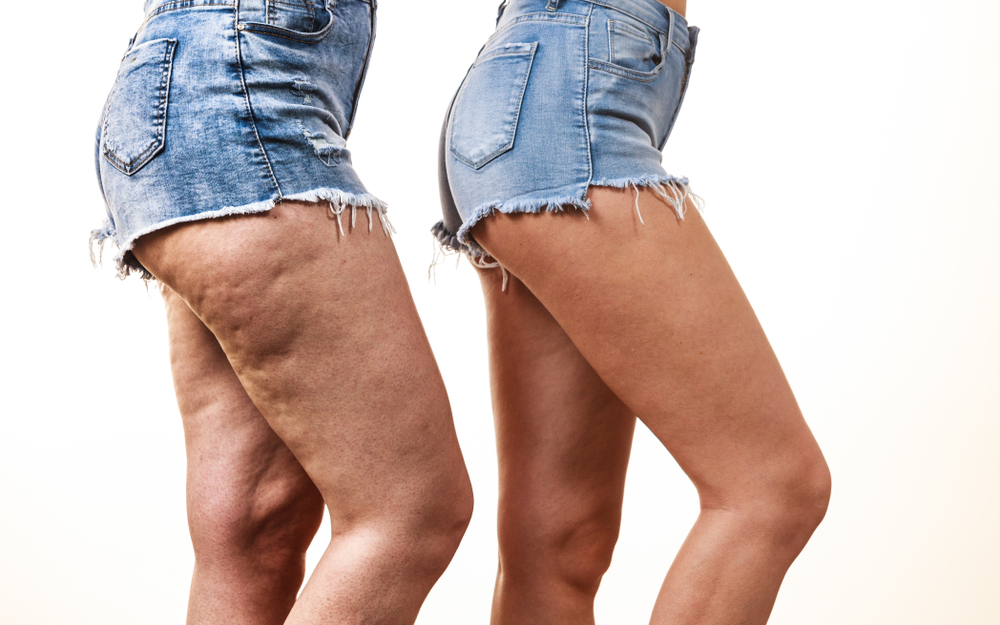Cellulite can disrupt the smoothness of your skin, creating an unwanted textured appearance that affects both men and women. Despite a healthy lifestyle, this condition might persist in areas like the thighs, buttocks, and abdomen.
Many individuals have experimented with various creams, scrubs, and over-the-counter products only to find minimal improvements in reducing cellulite. Recognizing this, we offer treatments that can get at the underlying factors of cellulite formation. At AURAE MD, we serve San Diego and La Jolla, CA, and we know that a deeper knowledge of cellulite and its causes can lead to better cellulite treatment results. Our goal is to provide this information for each of our patients.
What Is Cellulite?
Cellulite refers to the dimpled, lumpy skin texture commonly observed on the thighs, buttocks, and abdomen. This condition results from fat deposits that push through the connective tissue beneath the skin, which can create that distinctive look. It is a skin characteristic that affects people of all skin types, ages, and body types.
What Causes Cellulite?
The formation of cellulite is attributed to an interplay between the fat beneath the skin and the connective tissue that secures it. As fat cells expand, they push upwards against the skin, while the long, connective tissues hold the skin down. This tug-of-war results in the uneven surface that cellulite is known for. Factors like hormonal changes, age, and lifestyle choices can exacerbate the visibility and severity of cellulite.
Do Genetics Play a Role in Cellulite?
Genetics can influence the likelihood and extent of cellulite development. If your family members have cellulite, you are more prone to developing it due to several different inherited traits. While genetic predisposition is significant, it also interacts with other factors, meaning genetics is not the sole determinant of cellulite presence or severity.
Genetic Factors That Can Affect Cellulite
Skin Thickness
Skin thickness varies from person to person, influencing the appearance of cellulite. Thinner skin may make cellulite more noticeable as the underlying fat cells become more visible. Thicker skin can help mask the bumpy texture and reduce the prominence of cellulite.
Distribution of Fat Cells
The way fat cells are distributed under the skin also plays a role in cellulite development. An uneven distribution can lead to more pronounced cellulite, as clusters of fat cells push against the skin with varying intensities. The location of the fat, which can also be determined by genetics, can also make a difference in whether or not cellulite appears.
Connective Tissue Structure
The structure of connective tissue, which is largely determined by genetics, affects cellulite visibility. Strong, tightly woven connective tissues provide better support for fat cells, reducing the chances of cellulite formation. Certain types of connective tissues, however, allow fat cells to protrude more easily.
Gender
Gender is a significant genetic factor in cellulite occurrence. Women are more likely to develop cellulite than men due to differences in fat distribution, muscle structure, and connective tissue layout. Women have connective tissue that is vertical while male connective tissue tends to criss-cross, which makes it less likely to cause fat to bulge.
Ethnicity
Ethnicity can influence the texture and structure of the skin, affecting cellulite visibility. Different ethnic backgrounds can make it more likely that you have cellulite, although it is common across all ethnic groups.
Metabolism
An individual’s metabolic rate, which is partially determined by genetics, can sometimes be a factor in cellulite formation. A faster metabolism can lead to lower body fat levels, potentially minimizing the appearance of cellulite.
More Myths About Cellulite
- Only Overweight Individuals Get Cellulite: This is a misconception; individuals of all body types can develop cellulite. It is the structure of fat and connective tissues, not just body weight, that contributes to cellulite formation.
- Extreme Dieting and Exercise Will Eliminate Cellulite: While a healthy lifestyle can reduce the visibility of cellulite, extreme dieting and rigorous exercise do not guarantee cellulite removal.
- Only Women Get Cellulite: Although more common in women, men can also develop cellulite. Gender-specific fat distribution and connective tissue structure contribute to its prevalence among women but do not exclude men.
- Cellulite Only Appears on the Legs: Cellulite can manifest in various areas, not just on the legs. It is also commonly found on the buttocks, abdomen, and arms.
Cellulite Treatment Options
Forma
Forma is a non-invasive body contouring technique that can smooth skin and reduce the appearance of cellulite using radiofrequency energy. The device heats the skin to encourage collagen production and improve skin elasticity. This method is gaining recognition because it offers a gentler and more comfortable approach to cellulite treatment.
BodyFX™
BodyFX combines deep tissue heating, radiofrequency energy, and suction to achieve cellulite removal. The treatment targets fat cells and the skin’s underlying structure, leading to a smoother, more contoured appearance. It is considered one of the best treatments for cellulite due to its comprehensive approach and long-lasting results.
QWO®
QWO is an injectable cellulite treatment used for treating moderate to severe cellulite in the buttocks of adult women. It works by breaking down the fibrous bands that contribute to the dimpled look of cellulite. The treatment involves a series of injections aimed at smoothing the skin and diminishing the dimpled texture.
Achieve Smoother Skin With Cellulite Treatments
Exploring cellulite treatments can lead to significant improvements in skin texture and self-confidence. At AURAE MD, we provide options in San Diego and La Jolla, CA, that can help you with your particular concerns regarding cellulite. For more details on our services, call (858) 461-8543 or reach out via our online form.

